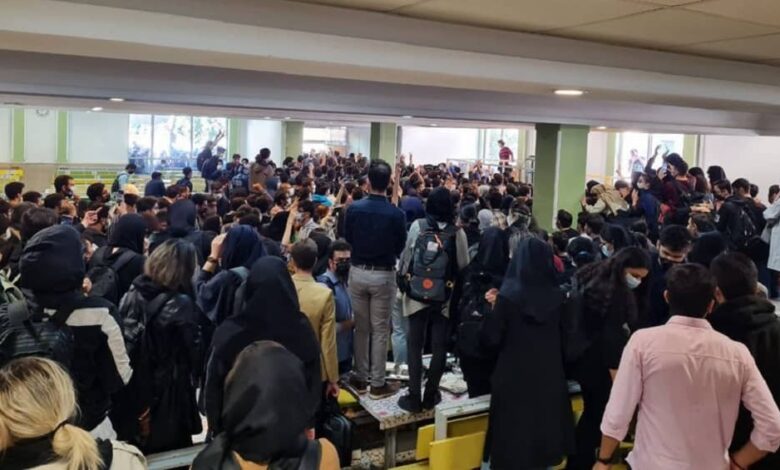Iranian Universities and Their Students Are an Everlasting Threat to Dictators

iran university basij attack
Written by
Mohammad Sadat Khansari
Students at a university in Iran were attacked by members of the paramilitary Basij units- 2022 Uprising
December 7 marked the National Student Day in Iran. On December 7, 1953, three students were gunned down by the Pahlavi regime’s oppressive forces outside Tehran University. On that day, the Iranian universities became the “bastion of freedom” and have stayed true to the form.
The memory of this national day, also known as “16 Azar,” has been kept alive with ceremonies and protests held by students in nearly all universities across Iran. Despite the Shah’s brutal crackdown on the students’ 1953 protests, Iranian universities stayed as the hub of resistance, where countless rebellious youth were attracted to the country’s opposition movements, the People’s Mojahedin Organization of Iran (PMOI/MEK), and the Iranian People’s Fedai Guerrillas. These students later became the leading figures of these movements, helping to raise awareness in Iran’s society and leading the 1979 anti-monarchial revolution.
While Ruhollah Khomeini, the ruling theocracy’s founder, was able to hijack the revolution, universities were the last bastions of freedom, opposing the mullahs’ backward rule. While Khomeini was trying to impose his reign of terror, twisting the real message of Islam, tens of thousands of Iranian university students attended classes of PMOI leader Massoud Rajavi, where he conveyed the real message of Islam: Freedom.
Seeing his regime’s legitimacy at stake, Khomeini called for the so-called “Cultural Revolution,” and his thugs stormed universities, killing and arresting those who sought the Iranian people’s longtime goal of democracy during the 1979 revolution. Tens of thousands of these university students, mostly MEK supporters, were brutally massacred during the early 1980s. Many of them form a large part of the over 30,000 victims of the 1988 massacre.
To strengthen its iron grip on universities, the mullahs’ regime established several oppressing institutions and bodies in universities, tasked with identifying and oppressing dissidents. Many of the regime’s agents were sent to Iran’s universities as “professors” or “students,” without any scientific background.
The daily recap of #IranProtests2022
Sunday, October 23
Today, university students across #Iran continued their demonstrations.
#IranRevoIution2022 #MahsaaAmini pic.twitter.com/3kvgBGEDqY— NCRI-FAC (@iran_policy) October 23, 2022
Yet, the mullahs failed to control the “bastion of freedom.” In 1998, thousands of Iranian university students in Tehran held protests and clashed with the regime’s security forces. Despite the regime’s heavy crackdown, university students continued their opposition to the regime. They played a leading role in the following uprisings in 2009, 2011, 2018, and 2019, and the major protests in 2022. In other words, the torch and banner of fighting for freedom passed from one generation to another across Iranian universities.
The Iranian university students played a very important role during the 2022 major protests, which erupted after the tragic death of Mahsa Amini in September 2022 and lasted for about seven months.
While the regime and its overt and covert allies were trying to resuscitate the long-decayed monarchy, the Iranian universities and students preserved the democratic nature of the revolution in the making by popularizing the chant of “down with the oppressor, be it the Shah or the mullahs.”
1/ “My compatriots are bravely fighting the regime. Khamenei’s forces brutally oppress people, but people won't back down. We are organized, therefore, able to continue our uprising. The democratic #IranRevolution prevails,” Freshteh, a 19 yrs old law student, tells @AlArabiya_Fa https://t.co/blVjbmkv1o
— NCRI-FAC (@iran_policy) December 5, 2022
A testament to the university students’ bravery and commitment to realizing democracy and freedom in Iran is the letter penned by Amir Hossein Moradi and Ali Younesi, two elite students arrested a few years ago for allegedly supporting the MEK.
“We observe this year’s 16 Azar in a context where the Islamic Republic, apprehensive of a potential uprising persisting until the attainment of freedom, has executed mass arrests and executions. Simultaneously, it aims to perpetuate a cycle of despair, possibly intending to prolong its stay in power amid this interplay of fear and desperation. This effort, however, has proven futile, unable to thwart the uprisings of 1998, 2009, 2018, and 2019. The regime is incapable of impeding the imminent uprising,” they wrote.
Moradi and Younesi further explained, “University students have demonstrated their significance both during and after uprisings. Today, as both youthful individuals and intellectuals, they have the capability to dispel any hesitations and unfounded theories, such as speculation about ‘who will succeed the current regime.’ The reality is that no one is poised for success. Indeed, dictatorial regimes, be they the Shah’s or the Mullahs’, are destined to collapse, making way for the establishment of a genuine and democratic republic. This underscores the potential and impactful role of university students, a force that unsettles the regime, prompting it to intensify its oppression against both students and their professors.”
In a nutshell, Iranian university students not only play a major role in guiding Iran’s society toward freedom and democracy, but they are also guardians of the democratic essence of revolution making. As Ali and Amir Hossein wrote, “The university students have shown that they will not surrender in this fight, which is our real fight.”
Iranian Universities and Their Students Are an Everlasting Threat to Dictators

